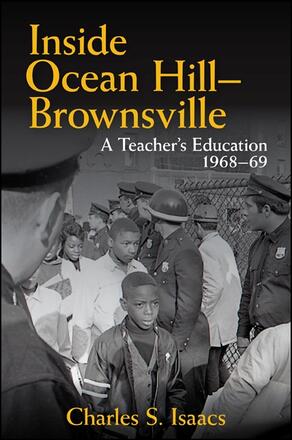
Inside Ocean Hill–Brownsville
A Teacher's Education, 1968-69
Alternative formats available from:
The story of an Ocean Hill–Brownsville teacher who crossed picket lines during the racially charged New York City teachers’ strike of 1968.
Description
Silver Winner, 2014 ForeWord IndieFab Book of the Year Award in the Education Category
In 1968 the conflict that erupted over community control of the New York City public schools was centered in the black and Puerto Rican community of Ocean Hill–Brownsville. It triggered what remains the longest teachers' strike in US history. That clash, between the city's communities of color and the white, predominantly Jewish teachers' union, paralyzed the nation's largest school system, undermined the city's economy, and heightened racial tensions, ultimately transforming the national conversation about race relations.
At age twenty-two, when the strike was imminent, Charles S. Isaacs abandoned his full scholarship to a prestigious law school to teach mathematics in Ocean Hill–Brownsville. Despite his Jewish background and pro-union leanings, Isaacs crossed picket lines manned by teachers who looked like him, and took the side of parents and children who did not. He now tells the story of this conflict, not only from inside the experimental, community-controlled Ocean Hill–Brownsville district, its focal point, but from within ground zero itself: Junior High School 271, which became the nation's most famous, or infamous, public school. Isaacs brings to life the innovative teaching practices that community control made possible, and the relationships that developed in the district among its white teachers and its black and Puerto Rican parents, teachers, and community activists.
Charles S. Isaacs is a former schoolteacher, college professor, social activist, community organizer, financial analyst, and occasional journalist. He is currently an independent real estate advisor to New York City's nonprofit community. He resides in Newburgh, New York.
Reviews
"…[the book] offers our first extensive insider's view into the strikes themselves and into far more unknown territory: what it was like to teach in the school … this volume offers an important coda to the story of Ocean Hill–Brownsville and to histories of minority education in the period, which often provide more information on the politics surrounding schools than on what happens within them. For that reason, this book is especially useful for labor historians, education historians, and readers interested in the history of grassroots movements for school improvement." — Labor
"Isaacs was an inveterate note-taker, and this engrossing, heart-breaking book draws heavily upon his often-verbatim reports of meetings and events, supplemented by a thorough knowledge of other published works about the controversy. The result is equal parts memoir and polemic, a passionate defense of community control and an excoriation of those who crushed it." — Labor Studies Journal
"The power of the story is that Isaacs offers not just a firsthand account of life inside the classroom walls at JHS 271, he also provides valuable insight for those preparing to teach or currently teaching in urban public schools." — Theory, Research, and Action in Urban Education
"…Isaacs offers a compelling inside account … [his] generally positive minority report on the experimental school district in Ocean Hill–Brownsville evokes a reverberating problem that the evolution of school governance has still not resolved: the role of parents." — New York Times
"Inside Ocean Hill–Brownsville is one of the finest accounts of this turbulent time in America's educational history. As a firsthand analysis of a teacher embroiled in the Ocean Hill–Brownsville community fight for educational justice, it has no peer. From its vantage point forty-five years after the conflict, we finally have a corrective to a plethora of secondhand analyses that have been written over the years. It is a candid picture that I recommend highly." — Maurice R. Berube, coeditor of Confrontation at Ocean Hill–Brownsville
"Inside Ocean Hill–Brownsville makes a vital contribution to a much-needed reinterpretation of the epochal struggles over community control of the New York City public schools in the 1960s, and the divisive UFT fall 1968 strikes in opposition to that community-based movement. Writing from the firsthand perspective of a young Jewish math teacher at JHS 271, Isaacs brings this important story vividly to life with insight, candor, and humor. He evokes the attitudes and actions of a rich array of ordinary teachers, administrators, students, and parents who fought to defend the community-control experiment in the face of the lies and distortions perpetrated by UFT officials and the mainstream press. A must read for anyone interested in creating successful public schools, this book helps us remember what democratic public education might look like." — Stephen Brier, The Graduate Center, City University of New York
"Charles Isaacs's Inside Ocean Hill–Brownsville is a firsthand account of the dramatic events of New York City's greatest school crisis. Isaacs debunks many of the popular myths of black militants waging assaults on teachers. Instead, he demonstrates that the episode in Ocean Hill–Brownsville was a case of black and Latino parents, with the support of a number of teachers at JHS 271, struggling for the education of their children and for a more democratically run educational system. These parents faced one of the most powerful unions in the city and a bureaucratic board of education that wanted to protect the status quo. There have been many books written on the 1968 teachers' strike, but Isaacs's well-written, detailed account is by far the best." — Clarence Taylor, author of Knocking at Our Own Door: Milton A. Galamison and the Struggle to Integrate New York City Schools